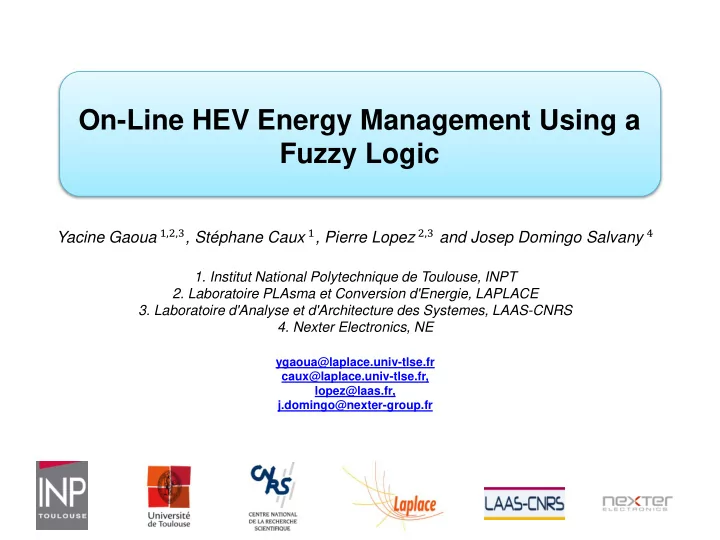

On-Line HEV Energy Management Using a Fuzzy Logic Yacine Gaoua 1,2,3 , Stéphane Caux 1 , Pierre Lopez 2,3 and Josep Domingo Salvany 4 1. Institut National Polytechnique de Toulouse, INPT 2. Laboratoire PLAsma et Conversion d'Energie, LAPLACE 3. Laboratoire d'Analyse et d'Architecture des Systemes, LAAS-CNRS 4. Nexter Electronics, NE ygaoua@laplace.univ-tlse.fr caux@laplace.univ-tlse.fr, lopez@laas.fr, j.domingo@nexter-group.fr
Outline of the presentation I. Introduction to HEV energy chain II. Sources characteristics III. Modeling IV. Solving method V. Off-line optimization VI. Results and performance VII. Conclusion
I. HEV energy chain Hybrid Electrical Vehicle HEV energy chain Battery Super-capacitor Fuel cell
II. Sources characteristics Parameter Meaning 𝑱 𝒅𝒊 Demand of the powertrain (A) 𝒏𝒋𝒐 , 𝑱 𝒃 𝒏𝒃𝒚 𝑱 𝒃 Min/Max current exiting the PCube converter (A) 𝒏𝒋𝒐 , 𝑱 𝒕𝒅 𝒏𝒃𝒚 𝑱 𝒕𝒅 Min/Max current provided by the super-capacitor (A) 𝒏𝒋𝒐 , 𝑽 𝒕𝒅 𝒏𝒃𝒚 , 𝑽 𝒕𝒅 (0) 𝑽 𝒕𝒅 Min/Max/Initial voltage of the super-capacitor (V) 𝒏𝒋𝒐 , 𝑻𝑷𝑫 𝒄𝒃𝒖 𝒏𝒃𝒚 , 𝑻𝑷𝑫 𝒄𝒃𝒖 (0) 𝑻𝑷𝑫 𝒄𝒃𝒖 Min/Max/Initial energy level in the battery pack (%) 𝑫𝒃𝒒 𝒄𝒃𝒖 Battery capacity (Ah) 𝜠𝒖 Time stepsize (s) 𝑺 𝒕𝒅 Super-capacitor internal resistance (Ω) 𝑫 𝒕𝒅 Super-capacitor capacity (F) 𝑭𝑴𝒑𝒕𝒕 𝒄𝒃𝒖 Battery energy losses (kW) E 𝑴𝒑𝒕𝒕 𝒅𝒘𝒕 Energy losses of the PCube converter (kW) Input parameters. Battery efficiency. Convertor efficiency.
III. Modeling Mathematical modeling Goal: Minimize battery discharge Under constrains of (system functioning, sources design, safety limitation), 𝐽 𝑐𝑏𝑢 + 𝐽 𝑏 = 𝐽 𝑑ℎ 𝐽 𝑑ℎ > 0 𝐽 𝑑ℎ ≤ 𝐽 𝑐𝑏𝑢 + 𝐽 𝑏 ≤ 0 𝐽 𝑑ℎ ≤ 0 𝑁𝑗𝑜 ≤ 𝐽 𝑏 ≤ 𝐽 𝑏 𝑁𝑏𝑦 𝐽 𝑏 𝑁𝑗𝑜 ≤ 𝐽 𝑡𝑑 ≤ 𝐽 𝑡𝑑 𝑁𝑏𝑦 𝐽 𝑡𝑑 𝑁𝑗𝑜 ≤ 𝑉 𝑡𝑑 ≤ 𝑉 𝑡𝑑 𝑁𝑏𝑦 𝑉 𝑡𝑑 𝑁𝑗𝑜 ≤ 𝑇𝑃𝐷 𝑐𝑏𝑢 ≤ 𝑇𝑃𝐷 𝑐𝑏𝑢 𝑁𝑏𝑦 𝑇𝑃𝐷 𝑐𝑏𝑢 𝑆 = 𝑄 + 𝐹𝑚𝑝𝑡𝑡 𝑐𝑏𝑢 (𝑄 ) ( nlp ) 𝑄 𝑐𝑏𝑢 𝑐𝑏𝑢 𝑐𝑏𝑢 2 = 𝑄 + 𝐹𝑚𝑝𝑡𝑡 𝑑𝑤𝑡 𝑄 + 𝑆 𝑡𝑑 𝐽 𝑡𝑑 𝑄 𝑡𝑑 𝑏 𝑏 Decision variables: 100.𝐹 𝑐𝑏𝑢 𝑇𝑃𝐷 𝑐𝑏𝑢 = 𝑇𝑃𝐷 𝑐𝑏𝑢 0 + ∆𝑢 𝐷𝑏𝑞 𝑐𝑏𝑢 ∆𝑢 𝑉 𝑡𝑑 = 𝑉 𝑡𝑑 0 + 𝐽 𝑡𝑑 + 𝑆 𝑡𝑑 + 𝐷 𝑡𝑑 𝑺 : Real battery current • 𝑱 𝒄𝒃𝒖 𝑱 𝒄𝒃𝒖 : battery current • 𝑉 𝑐𝑏𝑢 = 𝑔 𝑇𝑃𝐷 𝑐𝑏𝑢 0 𝑻𝑷𝑫 𝒄𝒃𝒖 : Battery State of charge • 𝑆 𝐹 𝑐𝑏𝑢 = 𝐽 𝑐𝑏𝑢 𝑽 𝒄𝒃𝒖 : Battery voltage • • 𝑱 𝒕𝒅 : Super-capacitor current • 𝑽 𝒕𝒅 : Super-capacitor voltage 𝒉 : Computation of electrical quantity 𝑱 𝒃 : Convertor current • 𝒈 : Computation of battery voltage
IV. Solving method using fuzzy logic Super-capacitor voltage. Battery current. Powertrain demand. Parameters setting: Genetic algorithm (off-line - GPS) Control and correction algorithm 𝒋𝒈 𝑱 𝒅𝒊 = . 𝒃𝒐𝒆 𝑽 𝒕𝒅 = . 𝒖𝒊𝒇𝒐 𝑱 𝒄𝒃𝒖 = . 𝒑𝒔 Rules generation. Decision surface (centroid method). Rules engine.
V. Off-line optimization Global optimization 𝑵𝒋𝒐 𝟐𝟏𝟏 − 𝑻𝑷𝑫 𝒄𝒃𝒖 𝑼 = 𝑵𝒃𝒚 𝑻𝑷𝑫 𝒄𝒃𝒖 𝑼 𝐽 𝑐𝑏𝑢 (𝑢) + 𝐽 𝑏 (𝑢) = 𝐽 𝑑ℎ (𝑢) 𝐽 𝑑ℎ (𝑢) > 0 𝐽 𝑑ℎ ≤ 𝐽 𝑐𝑏𝑢 + 𝐽 𝑏 ≤ 0 𝐽 𝑑ℎ (𝑢) ≤ 0 𝑁𝑗𝑜 ≤ 𝐽 𝑏 (𝑢) ≤ 𝐽 𝑏 𝑁𝑏𝑦 𝐽 𝑏 𝑁𝑗𝑜 ≤ 𝐽 𝑡𝑑 (𝑢) ≤ 𝐽 𝑡𝑑 𝑁𝑏𝑦 𝐽 𝑡𝑑 𝑁𝑗𝑜 ≤ 𝑉 𝑡𝑑 𝑢 ≤ 𝑉 𝑡𝑑 𝑁𝑏𝑦 𝑉 𝑡𝑑 𝑁𝑗𝑜 ≤ 𝑇𝑃𝐷 𝑐𝑏𝑢 (𝑢) ≤ 𝑇𝑃𝐷 𝑐𝑏𝑢 𝑁𝑏𝑦 𝑇𝑃𝐷 𝑐𝑏𝑢 ( nlp) 𝑆 𝑢 = 𝑄 𝑐𝑏𝑢 𝑢 + 𝐹𝑚𝑝𝑡𝑡 𝑐𝑏𝑢 𝑄 𝑐𝑏𝑢 𝑢 𝑄 𝑐𝑏𝑢 Mission profile NE (176s). 𝐽 𝑡𝑑 (𝑢) 2 (𝑢) = 𝑄 (𝑢) + 𝐹𝑚𝑝𝑡𝑡 𝑑𝑤𝑡 𝑄 (𝑢) + 𝑆 𝑡𝑑 𝑄 𝑡𝑑 𝑏 𝑏 100.𝐹 𝑐𝑏𝑢 𝑢 𝑇𝑃𝐷 𝑐𝑏𝑢 𝑢 = 𝑇𝑃𝐷 𝑐𝑏𝑢 𝑢 − 1 + ∆𝑢 𝐷𝑏𝑞 𝑐𝑏𝑢 ∆𝑢 𝑉 𝑡𝑑 (𝑢) = 𝑉 𝑡𝑑 𝑢 − 1 + 𝐽 𝑡𝑑 (𝑢) + 𝑆 𝑡𝑑 + 𝐷 𝑡𝑑 𝑉 𝑐𝑏𝑢 = 𝑔 𝑇𝑃𝐷 𝑐𝑏𝑢 𝑢 − 1 𝑆 (𝑢) 𝐹 𝑐𝑏𝑢 = 𝐽 𝑐𝑏𝑢 Optimization using Operations Research methods: AMPL+ IpOpt algorithm (Interior Points)
VI. Results and performance HEV sources/ Number of cycles / HEV sources/ Number of cycles / Battery discharge Battery discharge Method Method HEV battery alone 30 Cycles – 88.3143% HEV battery alone 1 Cycle – 52.3566% HEV with PCube - FL HEV with PCube - FL 34 Cycles – 88.8872% 2 Cycles – 85.7596% HEV with PCube - GAFL 35 Cycles – 87.6296% HEV with PCube - GAFL 2 Cycles – 71.9029% HEV with PCube − IpOpt 39 Cycles – 88.7396% HEV with PCube − IpOpt 3 Cycles – 89.896% Battery discharge (1 cycle) Battery discharge (1 cycle) HEV with PCube HEV with PCube GAFL GAFL 2.546% 36.1712% IpOpt IpOpt 2.29315% 30.49% NE Mission profile 176s. Mission profile 3h 50min.
VII. Conclusions and perspectives Conclusions: • Genetic algorithm improve the solution by setting FL parameters off-line, • Good quality of the results (in regard to the global optimization), • Development of decision support tool in C + + (implementation in a dsp target). Perspectives: • Validation of results on a real prototype.
Thank you for your attention ygaoua@laplace.univ-tlse.fr caux@laplace.univ-tlse.fr, lopez@laas.fr, j.domingo@nexter-group.fr
Recommend
More recommend